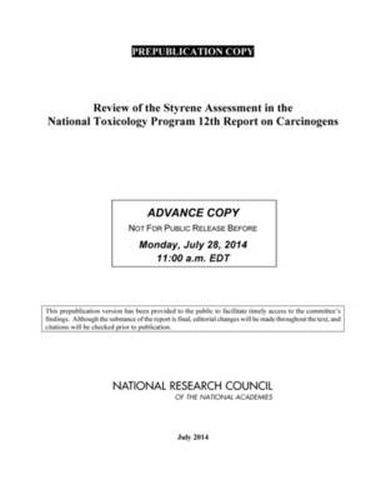Review of the Styrene Assessment in the National Toxicology Program 12th Report on Carcinogens
National Research Council,Division on Earth and Life Studies,Board on Environmental Studies and Toxicology,Committee to Review the Styrene Assessment in the National Toxicology Program 12th Report on Carcinogens

Review of the Styrene Assessment in the National Toxicology Program 12th Report on Carcinogens
National Research Council,Division on Earth and Life Studies,Board on Environmental Studies and Toxicology,Committee to Review the Styrene Assessment in the National Toxicology Program 12th Report on Carcinogens
Many people in the United States are exposed to styrene. Sources of environmental exposure included food (from migration of styrene from polymer packaging materials), cigarette smoke, vehicle exhaust and other forms of combustion and incineration of styrene polymers. Occupational exposure to humans can occur during the industrial processing of styrene. It is used to create a broad spectrum of products, including latex paints and coatings; synthetic rubbers; construction materials, such as pipes, fittings, and lighting fixtures; packaging; household goods, such as synthetic marble, flooring, and molded furnishings; and automotive parts. In 2011, the National Toxicology Program (NTP) listed styrene as reasonably anticipated to be a human carcinogen in its 12th Report on Carcinogens, marking the first time that the substance was listed. Congress directed the Department of Health and Human Services to arrange for the National Academy of Sciences to independently review the substance profile of styrene and it listing in the NTP report.
Review of the Styrene Assessment in the National Toxicology Program 12th Report on Carcinogens concurs with the NTP determination that there is limited but credible evidence that exposure to styrene in some occupational settings is associated with an increase in the frequency of lymphohematopoietic cancers. Additionally, the NRC report authoring committee independently reviewed the scientific evidence from studies in humans, experimental animals, and other studies relevant to the mechanisms of carcinogenesis and made level-of-evidence conclusions. Based on credible but limited evidence of carcinogenicity in traditional epidemiologic studies, on sufficient evidence of carcinogenicity in animals, and on convincing evidence that styrene is genotoxic in exposed humans, this report finds that compelling evidence exists to support a listing of styrene as, at a minimum, reasonably anticipated to be a human carcinogen.
This item is not currently in-stock. It can be ordered online and is expected to ship in approx 4 weeks
Our stock data is updated periodically, and availability may change throughout the day for in-demand items. Please call the relevant shop for the most current stock information. Prices are subject to change without notice.
Sign in or become a Readings Member to add this title to a wishlist.


